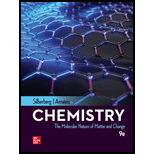
Concept explainers
(a)
Interpretation:
The four physical characteristics of solid metal are to be listed.
Concept introduction:
Metallic bonds are formed between metals. A metallic bond is formed between positively charged ions in a sea of delocalized electrons. The electrons in metals are delocalized over the entire metal.
The metallic character is characterized by the tendency of metals to lose their outermost valence shell electrons. Greater the ease of electron removal, higher will be the electropositivity of the corresponding elements and vice versa.
The metallic character is characterized by the tendency of metals to lose their outermost valence shell electrons.
(b)
Interpretation:
The two chemical characteristics of a metallic element are to be listed.
Concept introduction:
Metallic bonds are formed between metals. A metallic bond is formed between positively charged ions in a sea of delocalized electrons. The electrons in metals are delocalized over the entire metal.
The metallic character is characterized by the tendency of metals to lose their outermost valence shell electrons. Greater the ease of electron removal, higher will be the electropositivity of the corresponding elements and vice versa.
The metallic character is characterized by the tendency of metals to lose their outermost valence shell electrons.
Want to see the full answer?
Check out a sample textbook solution
Chapter 9 Solutions
CHEMISTRY:MOLECULAR...(LL)-W/CONNECT
- Nonearrow_forwardDraw structures corresponding to the following names and give IUPAC names for the following compounds: (8 Point) a) b) c) CH3 CH2CH3 CH3CHCH2CH2CH CH3 C=C H3C H H2C=C=CHCH3 d) CI e) (3E,5Z)-2,6-Dimethyl-1,3,5,7-octatetraene f) (Z)-4-bromo-3-methyl-3-penten-1-yne g) cis-1-Bromo-2-ethylcyclopentane h) (5R)-4,4,5-trichloro-3,3-dimethyldecanearrow_forwardNonearrow_forward
- Which of the following would you expect to be antiaromatic? Please provide a detailed explanation.arrow_forwardNonearrow_forwardDraw a Newman projection from carbon 3 to carbon 2 in the highest energy conformation for the following molecule. What is this conformation called? What kind of strain is present? Brarrow_forward
- Which of the following dienophiles is most reactive in a Diels-Alder reaction: Please explain why the correct answer to this question is option 5. Please provide a detailed explanation.arrow_forwardWhich of the following would you expect to be aromatic? Please provide a detailed explanation.arrow_forwardDraw the enantiomer and diastereomers of the following molecule. Label each type of stereoisomers. Label each chiral center as R or S. HOarrow_forward
 ChemistryChemistryISBN:9781305957404Author:Steven S. Zumdahl, Susan A. Zumdahl, Donald J. DeCostePublisher:Cengage Learning
ChemistryChemistryISBN:9781305957404Author:Steven S. Zumdahl, Susan A. Zumdahl, Donald J. DeCostePublisher:Cengage Learning ChemistryChemistryISBN:9781259911156Author:Raymond Chang Dr., Jason Overby ProfessorPublisher:McGraw-Hill Education
ChemistryChemistryISBN:9781259911156Author:Raymond Chang Dr., Jason Overby ProfessorPublisher:McGraw-Hill Education Principles of Instrumental AnalysisChemistryISBN:9781305577213Author:Douglas A. Skoog, F. James Holler, Stanley R. CrouchPublisher:Cengage Learning
Principles of Instrumental AnalysisChemistryISBN:9781305577213Author:Douglas A. Skoog, F. James Holler, Stanley R. CrouchPublisher:Cengage Learning Organic ChemistryChemistryISBN:9780078021558Author:Janice Gorzynski Smith Dr.Publisher:McGraw-Hill Education
Organic ChemistryChemistryISBN:9780078021558Author:Janice Gorzynski Smith Dr.Publisher:McGraw-Hill Education Chemistry: Principles and ReactionsChemistryISBN:9781305079373Author:William L. Masterton, Cecile N. HurleyPublisher:Cengage Learning
Chemistry: Principles and ReactionsChemistryISBN:9781305079373Author:William L. Masterton, Cecile N. HurleyPublisher:Cengage Learning Elementary Principles of Chemical Processes, Bind...ChemistryISBN:9781118431221Author:Richard M. Felder, Ronald W. Rousseau, Lisa G. BullardPublisher:WILEY
Elementary Principles of Chemical Processes, Bind...ChemistryISBN:9781118431221Author:Richard M. Felder, Ronald W. Rousseau, Lisa G. BullardPublisher:WILEY





